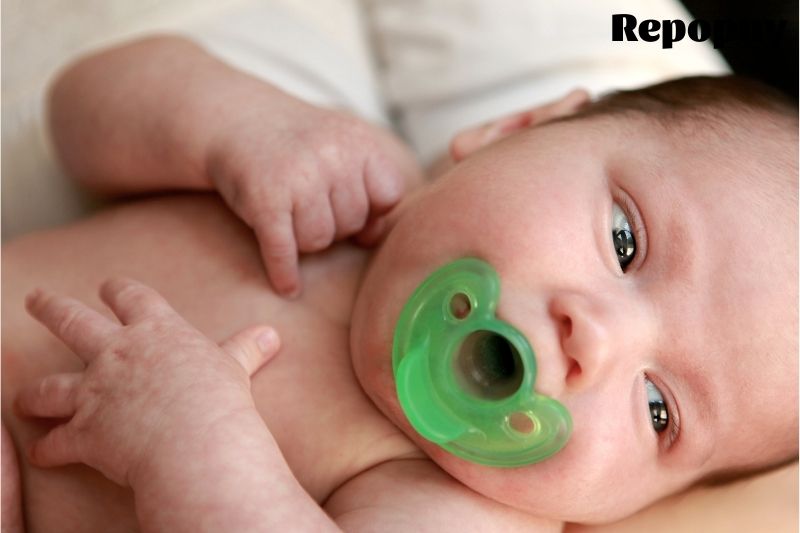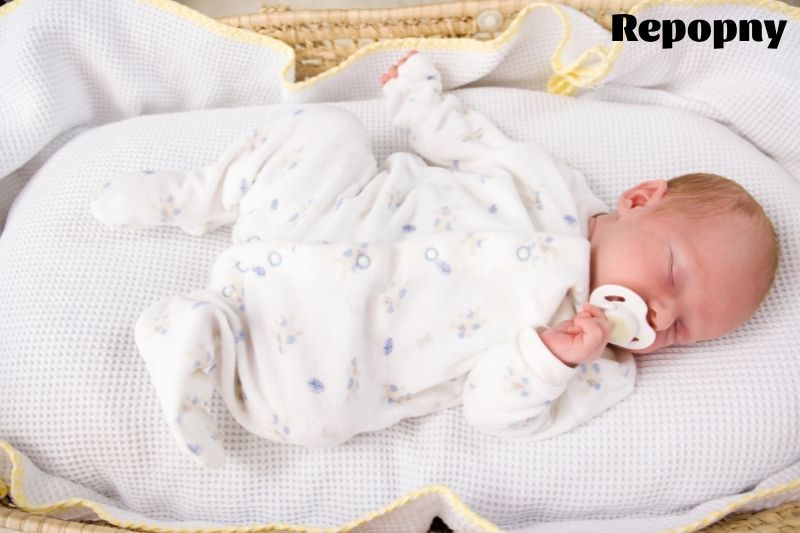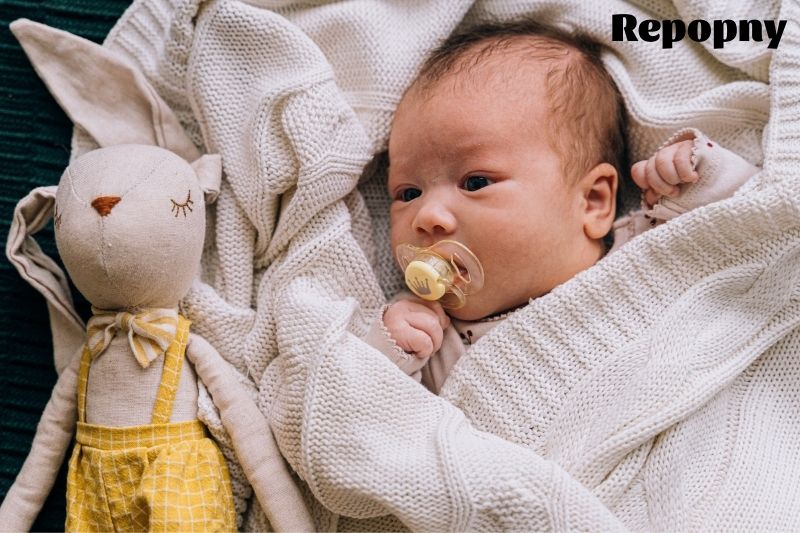A pacifier can be a lifesaver for parents of a fussy newborn. It can calm a baby when nothing else will, and it’s a natural way to soothe a baby. But can a newborn sleep with a pacifier?
When Is It Ok To Introduce A Pacifier?
If you’re debating whether or not to give your baby a pacifier, you’re undoubtedly concerned that they will have difficulty breastfeeding. The form of this product differs from that of a natural nipple, which might be confusing for an infant learning to latch on to the breast for milk. It’s only a matter of muscle memory.
According to this article, the physical action used by babies to suck on a pacifier differs from the physical action used to collect milk from the breast. The same is true when using a bottle. If a mother wishes to breastfeed, the pacifier should be placed on the shelf while the infant learns to obtain milk from the breast.
You can offer a pacifier to a baby who drinks from a bottle.
- 3-4 weeks for nursing babies and don’t have any latching issues.
- 4+ weeks or until the baby has mastered breastfeeding if they are breastfeeding and having problems latching.
- The idea is to develop a good breastfeeding routine before introducing a pacifier.
It’s also crucial for you as a new mother to ensure that your baby gets plenty of milk. It’s also easy to assume that your hungry baby is simply wailing to be soothed, and it’s tempting to go for the pacifier so you can take a well-deserved break!
The difficulty is that while the pacifier may be calming, your baby’s actual need – hunger – isn’t being satisfied. If you provide a pacifier too soon, you might unwittingly cut back on the much-needed milk that a baby is requesting.
When Should A Preterm Infant Start Using A Pacifier?
Premature babies need to start eating solid foods as soon as possible. This study from 2009 discovered that premature newborns that were given a pacifier were the ones who began oral feeding the quickest. Another fascinating finding from this study was that having premature babies listen to lullaby music helped develop early verbal eating behaviors.
Regardless of the findings of the initial study, you should always seek medical advice before introducing a pacifier to a premature baby.
10 Advantages Of Sleeping With A Pacifier For Babies
When it comes to your child’s sleep safety, doctors and experts believe that sleeping with their pacifier is safe for infants and babies.
To assist their infant’s sleep or stay asleep, many parents urge their newborns to sleep using pacifiers. Pacifiers can also calm a fussy infant before going to sleep, after a feeding, or after falling asleep again.
The following are ten advantages of pacifiers for sleeping babies:
- In newborns and babies, pacifiers minimize the incidence of Sudden Infant Death Syndrome (SIDS).
- Pacifiers help babies develop self-soothing skills that are important for their sleep cycles and routines.
- Pacifiers can help your baby fall asleep or wake up.
- Pacifiers can help calm a fussy baby.
- Preterm newborns that use pacifiers may gain more weight and spend less time in the hospital.
- Your baby’s natural sucking reflex is satisfied by pacifiers
- Research has shown that pacifiers can benefit colicky babies during their sleep routines or at night.
- During stressful or painful situations, such as immunization shots, pacifiers can be soothing to your child.
- On a flight, sucking can help reduce pain in the middle ear.
- When it’s time to break the habit, pacifiers can be thrown away. However, a baby’s thumb or fingers can’t.
Sleeping With A Pacifier Has Risks
Pacifiers may help babies receive the sleep they need, but they can also cause dental problems, ear infections, and oral yeast infections and potentially interfere with nursing.
Middle ear infections are more likely in babies who use pacifiers, but they are usually not a problem until the child reaches the age of 12 months. According to researchers, part of the higher risk can be ascribed to a youngster entering a childcare environment. Parents can lower the number of middle ear infections by limiting using a pacifier to sleep.
The usage of a pacifier can potentially cause a crossbite in which the top and lower teeth do not align properly. However, after the infant quits using it, the problem usually goes away. If the baby stops using it by three, it is unlikely to cause long-term problems.
Pacifiers give significant comfort to many babies, allowing them to satisfy their sucking reflex1 and self-soothe. Parents may be unsure when appropriate for their child to begin sleeping with it. In some circumstances, a newborn baby can start sleeping with it.
While bottle-fed babies can sleep with a pacifier from birth, breastfed babies should wait until they are at least 3 to 4 weeks old and have established a breastfeeding rhythm with no latching concerns before sleeping with one.
When Should You Introduce a Pacifier to a Newborn?
Babies may begin to use pacifiers at different stages, depending on their circumstances.
Breastfed Babies
The American Academy of Pediatrics (AAP) recommends avoiding using a pacifier until the infant is at least 3 to 4 weeks old and the mother and child have established a nursing habit. Introduce pacifiers sooner than this to avoid interfering with infant nursing success.
Many experts claim that using the pacifier can cause nipple confusion3, although there is no data to back this up. While some new research suggests that beginning this product as early as 2 weeks may be safe if your baby has successfully learned to breastfeed5, the AAP recommends waiting until your baby is roughly 1 month old.
There are a few circumstances in which pacifiers should be used sooner. A pediatrician, for example, may suggest that a newborn use the pacifier as part of a unique program to help them develop their oral motor skills. During specific medical procedures, pacifiers can also give pain relief. Before giving your kid a pacifier for the first time, speak with your pediatrician or the hospital staff.
Bottle-Fed Babies
Pacifiers can be used by bottle-fed newborns at any age, including shortly after delivery. If parents or caregivers opt to give their kids pacifiers, experts advise that they be used every time the baby sleeps, including during naps.
Premature Newborns Studies show that using a pacifier can help premature babies transition to oral eating, which should begin as soon as possible6 to help them thrive.
Sucking, swallowing, and breathing are all difficult for preterm babies. Premature babies are usually kept in the neonatal critical care unit until they learn to feed independently and can receive food through an oral or nasal tube. Pacifiers may aid in developing preterm babies’ sucking muscles, allowing them to begin feeding by mouth and gain weight more quickly.
According to a recent study, using it had no negative impact on the transition to breastfeeding, the time it took to learn to feed, or the length of hospital stay. Babies who were taught to suckle on the mother’s emptied breast rather than a pacifier were more likely to nurse exclusively after being discharged from the hospital.
Sleeping with a Pacifier Has Risks
Pacifiers may help babies receive the sleep they need, but they can also cause dental problems, ear infections, and oral yeast infections and potentially interfere with nursing.
Middle ear infections are more likely in babies who use pacifiers, but they are usually not a problem until the child reaches the age of 12 months. According to researchers, part of the higher risk can be ascribed to a youngster entering a childcare environment. Parents can lower the number of middle ear infections by limiting using this product to sleep.
The usage of this product can potentially cause a crossbite in which the top and lower teeth do not align properly. However, after the infant quits using this product, the problem usually goes away. If the baby stops using it by three, it is unlikely to cause long-term problems.
How To Introduce A Pacifier To Your Newborn In A Safe Way
If you decide to give your baby a pacifier, follow these guidelines for pacifier safety:
- Use the appropriate pacifier size for your child’s age: A smaller design can cause choking, so a pacifier shield should be wider than the baby’s mouth. A ring should be included to take the pacifier out of the baby’s mouth and a rough inside surface to reduce skin irritation. Keep an eye out for symptoms of wear and replace the pacifier as needed.
- Use pacifiers with only one piece: Use one-piece pacifiers that won’t fall apart and cause choking. Make sure the pacifier is made of sturdy material and has airflow holes. Reputable pacifier makers should be able to present a Children’s Product Certificate12 from the Consumer Product Safety Commission, indicating that they have met all applicable safety requirements.
- Attaching a thread, strap, or anything else to the pacifier could cause strangling or choking is not recommended. For this reason, pacifiers cannot be sold with strings, cords, or ribbons. Similarly, plush animals or toys should never be tied to a pacifier or placed in a sleeping infant’s cot. Avoid using pacifiers attached to the baby’s clothing or hanging around the neck at bedtime.
- Use a clean pacifier: Before handling the pacifier, keep it clean and wash your hands with warm soap and water13. Replace the pacifier regularly, and never use the same pacifier for multiple babies.
- Give your child a pacifier at naptime and nighttime: Always put your infant to bed on their back. If the pacifier slips out, it can stay out without replacing it. By the time they reach the age of seven months, newborns can usually retrieve the pacifier14 on their own if they desire it.
- Pacifiers are designed to comfort babies and should not be used to substitute for feeding. Older babies should not use pacifiers during busy times.
- Do not force your kid to take the pacifier if they are fussy or refuse it. When they are older, you can try again. Nothing tasty should be placed on the pacifier.
When Should You Stop Using a Pacifier to Help Your Baby Sleep?
Experts disagree on when to wean a baby off their pacifier, but most believe that caregivers should stop supplying pacifiers between the ages of 6 months and 4 years.
The American Academy of Pediatric Dentistry recommended that pacifiers be removed after your child reaches the age of three to avoid tooth problems.
The American Academy of Pediatrics and the American Academy of Family Physicians recommend reducing pacifier use between the ages of 6 and 12 months old to minimize middle ear infections. Some doctors recommend that a child discontinue using a pacifier when they are 14 months old to decrease the risk of a pacifier interfering with learning to speak.
Because the age range for removing the pacifier varies so widely among experts, the parent should decide when it is appropriate to remove the pacifier depending on its benefits, keeping in mind that the upper recommended age of 4 years should not be exceeded.
While pacifiers are essential for developing your baby’s sucking reflexes in the early stages of life, their value after 6 months is primarily due to the sensation of comfort they bring. You can provide age-appropriate alternatives to help your infant transition away from the pacifier and reduce anxiety.
Receiving a massage or having a lullaby played to them may give comfort to younger infants. Consider playing together with toddlers or encouraging them with words. Other items for self-soothing, such as a blanket, a beloved toy, or a stuffed animal, might also be comforting. Stopping abruptly might be effective as well.
FAQs
Is it possible for a baby to sleep with a pacifier?
A: According to the American Academy of Pediatrics and the Mayo Clinic, pacifiers are safe for your baby to sleep with. Studies have also discovered a link between pacifiers and a lower risk of SIDS.
Is it possible for a newborn to sleep with a pacifier?
A: Of course. It is suggested that a newborn be given a pacifier to assist lower the incidence of SIDS. Sucking a pacifier may help kids fall asleep and stay asleep for extended periods. If your baby is breastfeeding, you might want to start with that.
What is the best way to clean a pacifier?
All new pacifiers should be sterilized, according to Chicco. Use a dishwashing soap that is free of harsh chemicals while hand cleaning. Allow to air dry before squeezing out any remaining moisture.
Tips for reducing the risk of SIDS.
- Remove any blankets or pillows from the crib and use crib fitted sheets.
- When it’s time to sleep, lay your baby on its back.
- Make sure you’re sleeping on a firm, flat surface.
- Before going to bed, give your child a pacifier.
- Keep the baby in your room on a separate surface meant for infants for the first few months.
Is the blanket safe for the baby? Read our article to take care of your children best.
What is the best way to get an infant to sleep?
A: It is critical to pay attention to and recognize your newborn’s sleep cues despite the difficulty. This will allow you to immediately determine whether they are hungry, dirty, or ready to sleep. Time is essential since your newborn will get overtired and agitated as their waking window closes. This can significantly impact the quality of sleep your baby gets.
conclusion
From a medical point of view, it’s lovely for a newborn to sleep with a pacifier. But do not let your baby sleep with it and put it in the same bed as you.
This can be dangerous for your baby, but it can also be hazardous for your health and may cause you to become seriously ill. Repopny hopes this guide is useful for you.






